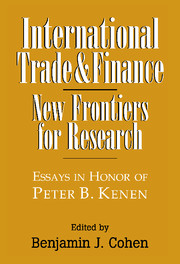Book contents
- Frontmatter
- Contents
- List of contributors
- Introduction
- 1 The practical theorist: Peter Kenen's contribution to international economics
- I International trade theory
- II International monetary theory
- III Applied policy analysis
- 9 Labor market adjustment and trade: Their interaction in the Triad
- 10 Do the G-3 countries coordinate monetary policy?
- 11 Fundamental determinants of Mexico's exchange-rate crisis of 1994
- 12 Devaluation cycles and adjustment costs
- 13 Payments problems in the Commonwealth of Independent States
- Index
11 - Fundamental determinants of Mexico's exchange-rate crisis of 1994
Published online by Cambridge University Press: 11 September 2009
- Frontmatter
- Contents
- List of contributors
- Introduction
- 1 The practical theorist: Peter Kenen's contribution to international economics
- I International trade theory
- II International monetary theory
- III Applied policy analysis
- 9 Labor market adjustment and trade: Their interaction in the Triad
- 10 Do the G-3 countries coordinate monetary policy?
- 11 Fundamental determinants of Mexico's exchange-rate crisis of 1994
- 12 Devaluation cycles and adjustment costs
- 13 Payments problems in the Commonwealth of Independent States
- Index
Summary
A theme throughout Peter Kenen's long and highly influential career has been the relationship between exchange rates and the real side of the economy. In theoretical models, empirical studies, or direct policy analysis, Kenen has always sought insight toward building sound economic and exchange-rate policies. In our joint work fifteen years ago on the asset-market approach to exchange rates (Allen and Kenen 1980), we examined links between the short-run determination of exchange rates in the financial markets and the ultimate importance of real factors in the current account for the long-run equilibrium exchange rate, focusing on the implications for economic integration.
The goal of this essay – to better understand some of the fundamentals leading up to the Mexican exchange-rate crisis in late 1994 – is sympathetic to Kenen's approach, at least in spirit, if not always in letter. The NATREX model that follows focuses on the real fundamentals of investment, saving, and long-run capital flows. Understanding the relationships of these flows to the real exchange rate and to the stability of an economy is a prerequisite for sound economic policy, particularly in countries facing rapid institutional changes, relatively inflexible prices, and volatile behavior of foreign investors.
In December 1994 Mexico's exchange-rate crisis and subsequent economic contraction sharply reversed a period of slow growth and optimism about the economy's imminent takeoff. The crisis followed a seven-year period of widely praised reforms by the Mexican government.
- Type
- Chapter
- Information
- International Trade and FinanceNew Frontiers for Research, pp. 316 - 338Publisher: Cambridge University PressPrint publication year: 1997
- 1
- Cited by



